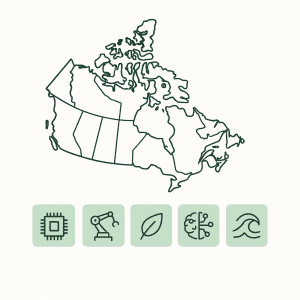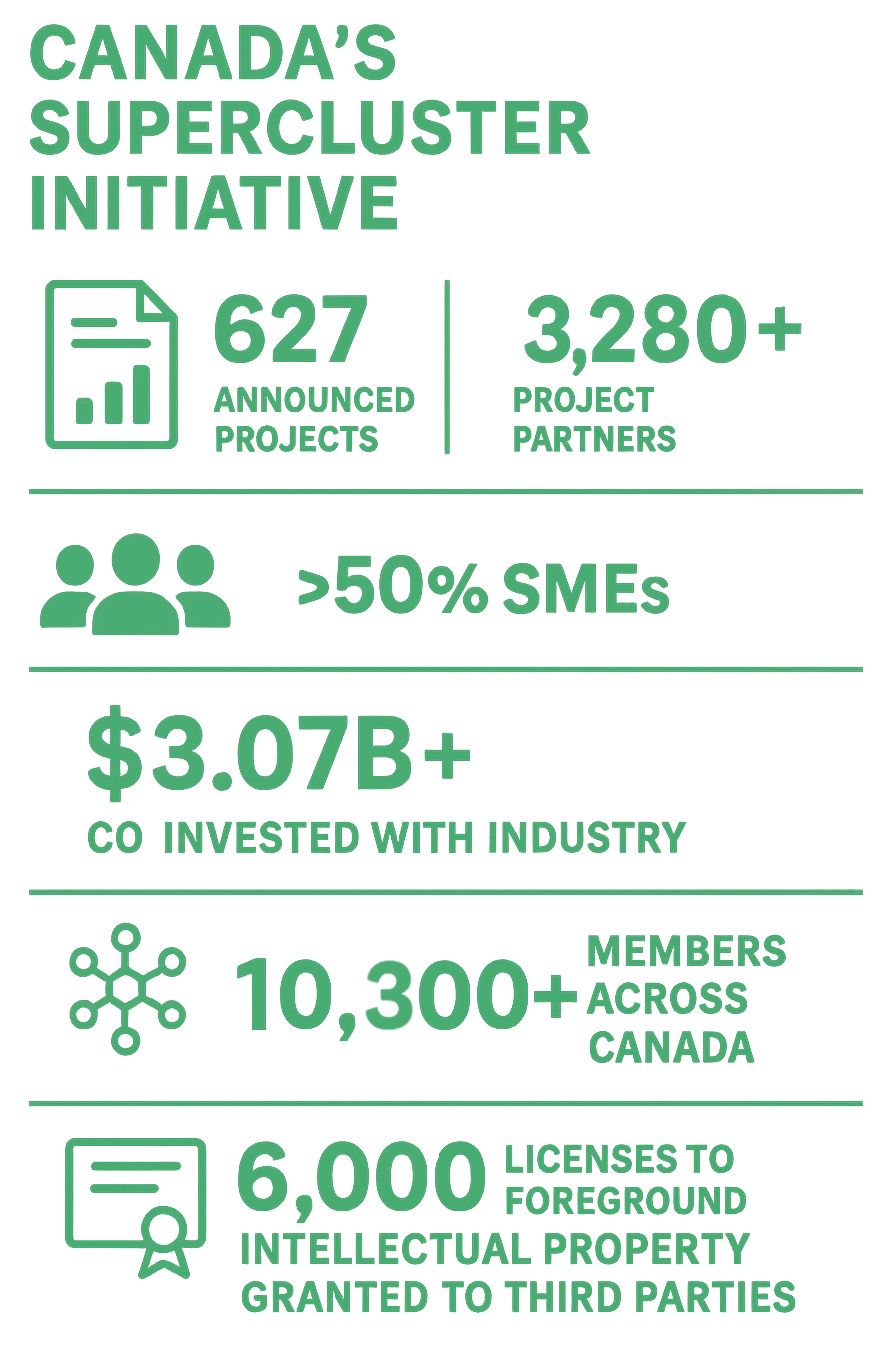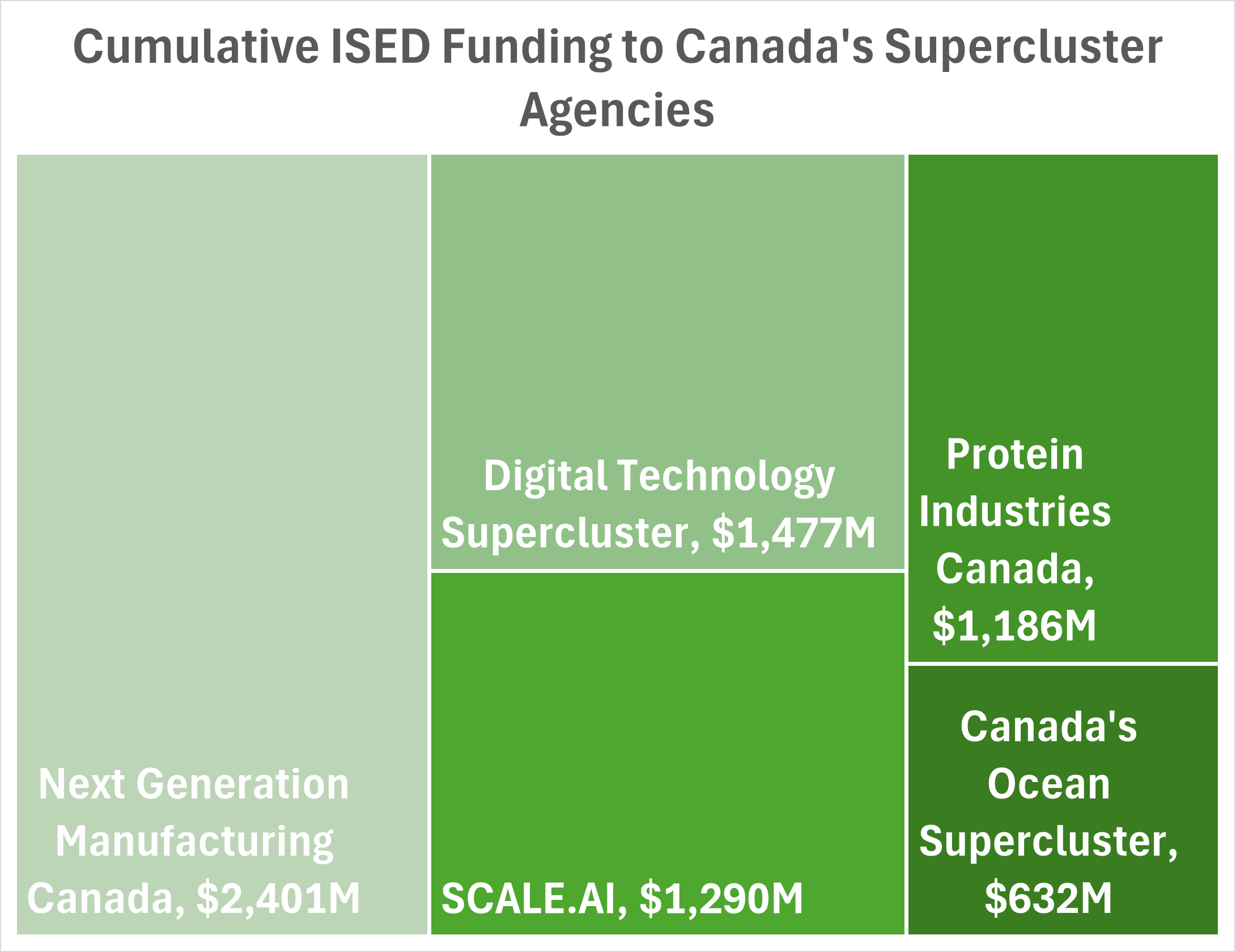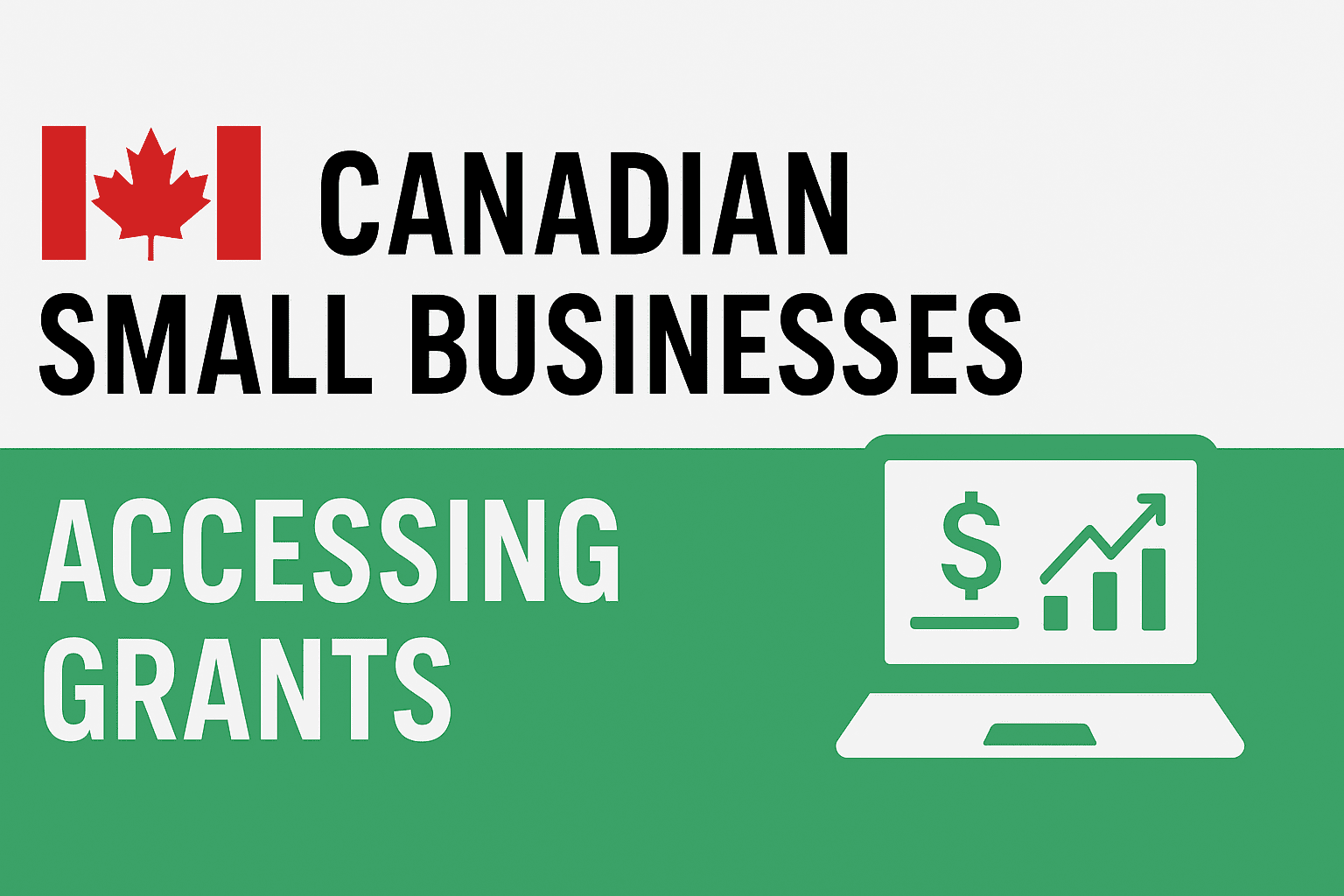Introduction to Canadian Supercluster Projects
From Clean Conduit, you’ll learn:
What the Global Innovation Clusters are
Why supercluster funding is critical for Canadian innovation
How to build a winning consortium, application, and supercluster project
Global Innovation Clusters
Canada’s Global Innovation Clusters program – formerly the Innovation Superclusters Initiative – stands out as a cornerstone of the country’s strategy to drive economic growth and global competitiveness. By focusing on five industry-led clusters – the Ocean Supercluster in Newfoundland and Labrador, Scale AI in Quebec, Next Generation Manufacturing Canada (NGen) in Ontario, Protein Industries Canada in Saskatchewan, and the Digital Technology Supercluster in British Columbia – Canada is leveraging its regional strengths to foster innovation in high-growth-potential sectors.

These clusters unite businesses and academic institutions to accelerate the development and commercialization of new technologies, including artificial intelligence, food technologies, augmented reality, maritime advances, cloud computing, and next generation manufacturing.
The Global Innovation Clusters operate as industry-led non-profits, supported through Innovation, Science and Economic Development Canada (ISED), and are responsible for project selection, oversight, and strategic alignment within their sectors.
The clusters are designed to break down silos, encouraging organizations of all sizes to work together on projects that have the potential to transform industries and create new jobs. This collaborative model not only supports the development of cutting-edge technologies but also ensures that advancements benefit a wide range of sectors.
By providing targeted funding and support for research and development, the Global Innovation Clusters program helps Canadian companies scale up, access new markets, and establish global leadership in emerging technologies. The initiative’s focus on commercial potential and economic impact ensures that investments translate into real-world benefits, from job creation to improved productivity and sustainability. As a result, Canada is increasingly recognized as a leader in fostering innovation ecosystems that deliver tangible results for businesses, communities, and the broader economy.

Benefits of Superclusters
Each of the five superclusters focuses on areas where Canada has a strong competitive potential, such as artificial intelligence and ocean technologies. These clusters provide funding and resources to support projects that develop new technologies and enhance the commercial potential of scientific discoveries. By encouraging collaboration among industry, academic institutions, and government, superclusters help accelerate the development of new technology and drive economic development across the country.
Innovation, Science, and Economic Development: The Policy Framework
Canada’s policy framework for innovation, science, and economic development is built around the concept of global innovation clusters, with the federal government playing a pivotal role in shaping the ecosystem. Through funding programs, the government aims to create an environment where businesses, academic institutions, and research organizations can thrive and collaborate.
A key element of this framework is the support for large companies and startups alike, encouraging them to work together to accelerate research and development. By providing access to funding, resources, and expertise, the government helps Canadian businesses scale up their operations, compete internationally, and create new jobs.
The policy framework also prioritizes collaboration, recognizing that innovation flourishes when diverse organizations pool their knowledge and resources. Programs are designed to facilitate partnerships across sectors and regions, ensuring that the benefits of innovation are widely shared. The emphasis on innovation reflects Canada’s commitment to staying at the forefront of global trends, driving economic growth, and supporting the creation of high-quality jobs.
Ultimately, the government’s approach to innovation science and economic development is about building a robust, inclusive, and future-ready economy. By investing in clusters, supporting research and development, and fostering a culture of collaboration, Canada is laying the groundwork for sustained economic success and global leadership in technology and innovation.
The Five Canadian Superclusters
The federal government established five clusters as part of the Innovation Superclusters Initiative to drive science and economic development, encourage collaboration, and support projects that benefit communities and companies across Canada. The federal government has since renamed these superclusters as ‘Global Innovation Clusters’ to emphasize international collaboration and the adoption of successful global models. These clusters focus on building innovation ecosystems and capacities by fostering partnerships and strengthening infrastructure.
Large companies play a significant role in supercluster projects, collaborating with startups, universities, and research institutions to drive innovation and support commercialization efforts.

Digital Technology Supercluster
Based in British Columbia, this supercluster serves as a hub for digital innovation in the region, creating opportunities for companies and communities to develop new technologies. Projects often leverage advanced technologies such as augmented reality and cloud computing to drive innovation.
Example funded project: Shaping the Future of Mining with Surgical Precision
Protein Industries Canada
Plant-based protein innovations, agriculture technology, and sustainable food production methods are key focus areas for this supercluster. By integrating cutting-edge research with industry expertise, projects aim to develop novel plant-based products that meet growing consumer demand while promoting environmental sustainability. This cluster supports advancements in agricultural technologies that enhance crop yields, improve crop health, and optimize supply chains, contributing to a more resilient and efficient food system in Canada.
Example funded project: Investment into Saskatchewan pea protein processing to create new Canadian food options
Next Generation Manufacturing Canada (NGen)
NGen funds projects that are transforming manufacturing processes across Canada. These technologies enable smarter, more efficient production lines through the integration of advanced sensors, data analytics, and machine learning. By adopting Industry 4.0 principles, NGen supercluster actively supports projects that develop and implement cutting-edge solutions, helping Canadian manufacturers stay competitive on the global stage and contribute to economic growth.
Example funded project: Redefining Housing With Robotics
Scale AI
Scale AI supports AI adoption, enabling companies to optimize operations, reduce costs, and improve efficiency through advanced data analytics and machine learning techniques. This focus area supports the development of innovative solutions that address complex supply chain challenges, helping businesses stay competitive in a rapidly evolving global market.
Example funded project: Port Logistics Optimization Tool
Canada’s Ocean Supercluster (OSC)
This supercluster is focused on ocean innovation on Canada’s coasts. It aims to harness the vast potential of marine industries by fostering collaboration among businesses, academic institutions, and government entities to develop innovative, sustainable ocean technologies and practices.
Example funded project: Cleaner, Smoother Natural Ship Bearings
Canadian Supercluster Funding Opportunities
Programs administered by the superclusters offer a variety of funding opportunity types, including grants and loans, to support projects in R&D, commercialization, technology adoption, education, training programs, and community development across different sectors. Projects are typically led by a consortium of partners from industry, academia, and other sectors.
Funding Amounts
Typical funding amounts vary with each supercluster. For example, Ocean Supercluster projects tend to be in the millions of dollars with a roughly 40% rate of funding, whereas Protein Industries projects tend towards the hundreds of thousands of dollars but with a higher funding rate of up to 75%.
Eligible project types
R&D, commercialization pilots, and education and training initiatives are key components of supercluster projects. These diverse project types enable the development and scaling of innovative technologies while building the necessary skills and knowledge within the Canadian workforce. Research and development activities focus on creating new products, processes, and services that address industry challenges and market needs. Commercialization pilots help validate these innovations in real-world settings, demonstrating their viability and paving the way for broader market adoption.
Education and training initiatives are designed to equip workers with the skills required to thrive in rapidly evolving industries, with special attention to underrepresented groups to promote diversity and inclusion. Together, these project categories foster a holistic innovation ecosystem that supports economic growth, global leadership, and the creation of new jobs across Canada.
Who Can Apply for Canadian Supercluster Funding
Eligible organizations include companies, universities, and non-profits. SMEs (small and medium-sized enterprises) are encouraged to participate in supercluster projects and can benefit significantly from collaboration and funding. Companies, communities, and other organizations can participate in supercluster projects, and the program supports the development of skills and capacity within these groups to drive innovation and economic growth. There are specific partnership and consortium requirements that applicants must meet. Additionally, project partners must have Canadian operations, although global collaboration opportunities are encouraged. Increasing awareness of supercluster opportunities among eligible organizations and communities is essential to ensure broad participation and maximize the impact of these initiatives.
Ready to apply?
Contact us to discuss your projects, initiatives, and goals:
How to Win a Canadian Supercluster Project
Step 1 – Engage Early with Supercluster Leadership
Attend events and info sessions
Seek pre-submission feedback
Learn about upcoming priorities and targeted funding initiatives
Step 2 – Align with the Supercluster’s Strategic Priorities
Match project goals to supercluster themes
Plan ahead of time, so that you aren’t waiting for funding to break ground
Show measurable Canadian economic impact
Step 3 – Build a Strong Consortium
Partner with diverse, complementary organizations
Demonstrate collaborative innovation capacity greater than the sum of your parts
Creating strong partnerships and encouraging collaboration among companies, communities, and academic institutions is essential for project success.
Step 4 – Highlight Innovation and Commercial Potential
Technology readiness level (TRL) considerations
Path to market and export opportunities
Intellectual property is created through collaborative projects, benefiting both the company and the broader community by generating new assets and knowledge.
Step 5 – Create a Strong Business Case
ROI for Canada: jobs, IP, exports, sustainability
A strong business case should clearly demonstrate the program’s aims, including global leadership, developing skills, and supporting the growth of involved companies and communities.
Leverage private investment to boost proposal strength
Engage with third parties like Clean Conduit to provide outsider insights and develop a bold vision. This is how to “go big,” and with 40% or more in matched funds and tons of publicity potential, you don’t want to leave opportunities on the table.
Common Mistakes That Lead to Rejection
Weak strategic alignment: Projects that do not clearly align with the supercluster’s strategic priorities or focus areas are less likely to be funded. It is essential to demonstrate how your project supports the specific goals of the supercluster, such as advancing digital technology, fostering collaboration, or driving economic growth within targeted sectors.
No committed industry partners: Supercluster funding emphasizes collaboration between industry players. Applications lacking confirmed commitments from industry partners, especially those who will contribute resources or expertise, may be rejected. Strong industry involvement signals project viability and relevance.
Lack of commercialization strategy: Projects must show a clear path to market, including plans for commercialization, scaling, and generating economic impact. Proposals without a defined commercialization strategy or evidence of market demand often fail to meet funding criteria.
Minimal co-investment: Superclusters require applicants to demonstrate significant co-investment, either financial or in-kind, from project partners. Insufficient matching funds or contributions can undermine the project’s credibility and reduce its chances of approval.
Ineligible partner organizations (collaborators vs partners): It is important to distinguish between collaborators who provide ancillary support and formal partners who actively participate and share in project responsibilities. Including organizations that do not meet eligibility criteria or lack commitment can lead to application rejection.
Failing to demonstrate how the project supports or benefits communities, or how it aligns with the aims of the program: Projects must clearly articulate their broader impact on Canadian communities, such as job creation, skills development, or supporting underrepresented groups. Applications that do not effectively convey these benefits or fail to align with program objectives risk being declined.
Tips to Improve Your Chances of Winning
Work with experienced grant writers: Collaborate with professionals like Clean Conduit, Inc. who have a proven track record in securing supercluster funding. Their expertise in navigating the application process, understanding evaluation criteria, and crafting persuasive proposals can significantly increase your chances of success.
Build relationships months before calls open, or use a grant writer’s network: Establish connections early with supercluster program managers, industry partners, and other stakeholders. This proactive networking helps you stay informed about upcoming funding priorities and allows you to form strong consortia. Alternatively, leverage the extensive networks of experienced grant writers to access valuable contacts and insights.
Reuse and adapt proven proposal content or strategies, if you have access to them: Utilize successful past proposals or templates as a foundation, tailoring them to fit the specific goals and requirements of the current funding call. This approach saves time and ensures that your application aligns with what reviewers are looking for.
Craft a solid business case that shows the ROI to Canada in terms the reviewers will understand: Develop a compelling narrative that clearly demonstrates how your project will deliver measurable economic benefits, such as job creation, intellectual property generation, and increased exports. Use data and examples to illustrate the potential impact on Canada’s innovation ecosystem and global competitiveness.
Leverage supports and resources provided by the program, and be actively involved in the supercluster community to maximize your project’s impact: Take advantage of workshops, mentorship programs, and networking events offered by the superclusters. Active participation helps you access valuable knowledge, build partnerships, and increase your project’s visibility, all of which contribute to a stronger proposal and greater project success.
Case Study: Cleaner, Smoother, Natural Ship Bearings
The Cleaner, Smoother, Natural Ship Bearings project was funded by Canada’s Ocean Supercluster after a successful application prepared by Clean Conduit, Inc. This $4.5 million project, led by Hydro Tech Inc. (based in Sault Ste. Marie, Ontario) in partnership with Canadian Maritime Engineering Ltd. (Dartmouth, Nova Scotia), aims to reinvent lignum vitae wood stern tube bearings, a century-old, naturally durable, and self-lubricating material that was historically used in marine applications. The upgraded, water-lubricated wood bearings, tailored for vessels over 40 feet, offer compelling advantages compared to traditional metal or synthetic composite bearings:
Reduced wear and failure rates
Zero oil discharge, significantly reducing environmental contamination
Improved fuel efficiency
PFAS-free composition, enhancing environmental safety and compliance
Canada’s Ocean Supercluster is investing $1.8 million, with the remaining funding coming from project partners. The project is also expected to generate approximately 50 new jobs across Atlantic Canada and Ontario in bearing manufacturing, engineering, and installation roles.
As part of the Ambition 2035 vision – Canada’s goal to grow its ocean economy fivefold to $220 billion by 2035 – this initiative exemplifies the commercialization of sustainable, high-performance ocean technology rooted in Canadian innovation and legacy, and provides substantial support to the applicants.
Strategic Impact Example: Improving Crop Health Through Supercluster Impact in Agri-Food Innovation
Canada’s Innovation Superclusters Initiative is making a significant impact on agri-food innovation, with a strong focus on improving crop health, a cornerstone for food security, sustainability, and economic growth. Through the collaborative efforts of the Protein Industries Canada supercluster and its partners, the country is harnessing the power of digital technologies.
Next Generation Superclusters: What’s on the Horizon?
Looking ahead, Canada’s global innovation clusters are poised to play an even more important role in shaping the future of the country’s economy. Emerging technologies such as augmented reality, artificial intelligence, and advanced digital platforms are expected to drive innovation across a range of sectors, from next generation manufacturing to precision agriculture.
One exciting development is the Canadian Tech Talent Accelerator at the Digital Supercluster, a program designed to equip underrepresented groups with the digital technology skills needed to thrive in the innovation economy. By providing targeted training and support, the accelerator is helping to build a more diverse and inclusive workforce, which is essential for driving long-term economic growth and global competitiveness.
The federal government continues to invest in research and development, offering grants and funding opportunities to support the creation and commercialization of new technologies. Municipal governments and communities are also being encouraged to get involved, helping to build a vibrant innovation ecosystem that spans the entire country.
As the global innovation clusters program evolves, collaboration between businesses, academic institutions, and government agencies will remain at the heart of Canada’s strategy. By fostering partnerships, supporting the development of next generation technologies, and ensuring that all Canadians have the opportunity to participate, the government of Canada aims to secure the country’s position as a global leader in innovation and economic development.
Conclusion
Winning supercluster funding gives businesses access to substantial non-dilutive capital, industry partnerships, and national innovation networks that accelerate growth and market impact. This means companies can secure significant financial resources without giving up equity, allowing them to invest in research, development, and commercialization activities. Additionally, being part of a supercluster connects businesses with key industry players, academic institutions, and government agencies, fostering collaboration that can lead to innovative solutions and expanded market opportunities across Canada and beyond.
Starting early and ensuring strategic alignment is key. A consultant can help you to understand what’s out there before you commit substantial resources. Early engagement allows your team to identify funding priorities, align your project goals with supercluster objectives, and build strong partnerships that enhance your proposal’s competitiveness. Consultants with experience in supercluster programs can provide valuable insights into application requirements, help you navigate complex processes, and optimize your chances of success by tailoring your approach to meet the expectations of funding bodies.
About Clean Conduit
Incorporated in 2014, Clean Conduit Inc. (CCI) is a boutique consultancy with a decade-long track record of securing public funding and delivering high-impact innovation projects across clean technology and other advanced sectors.
We specialize in helping companies win competitive funding, including from Canada’s Global Innovation Clusters, through expertly crafted proposals and strategic project design. Our team combines deep technical knowledge, engineering capability, and commercialization experience with an insider’s understanding of how to structure successful funding applications.
Why Choose Clean Conduit as Your Supercluster Partner?
We’re experienced technical writers who understand how to communicate complex ideas clearly and persuasively to funding reviewers.
We don’t just write; we shape your project. Using our in-house playbook, we help frame your initiative to align with each supercluster’s strategic goals, economic outcomes, and innovation priorities.
We support both the funding and delivery side. Our team includes engineers, entrepreneurs, and project managers who can help you execute once funding is secured, with our fulfillment fees often eligible for reimbursement under supercluster funding guidelines.
We’ve done it before. From maritime technology to AI, we’ve helped companies navigate the supercluster landscape and emerge with millions in non-dilutive funding and high-visibility projects.
With Clean Conduit, you gain a strategic ally who understands the unique demands of supercluster projects, from forming strong consortia and defining commercialization pathways to meeting TRL requirements and maximizing your return on investment.


